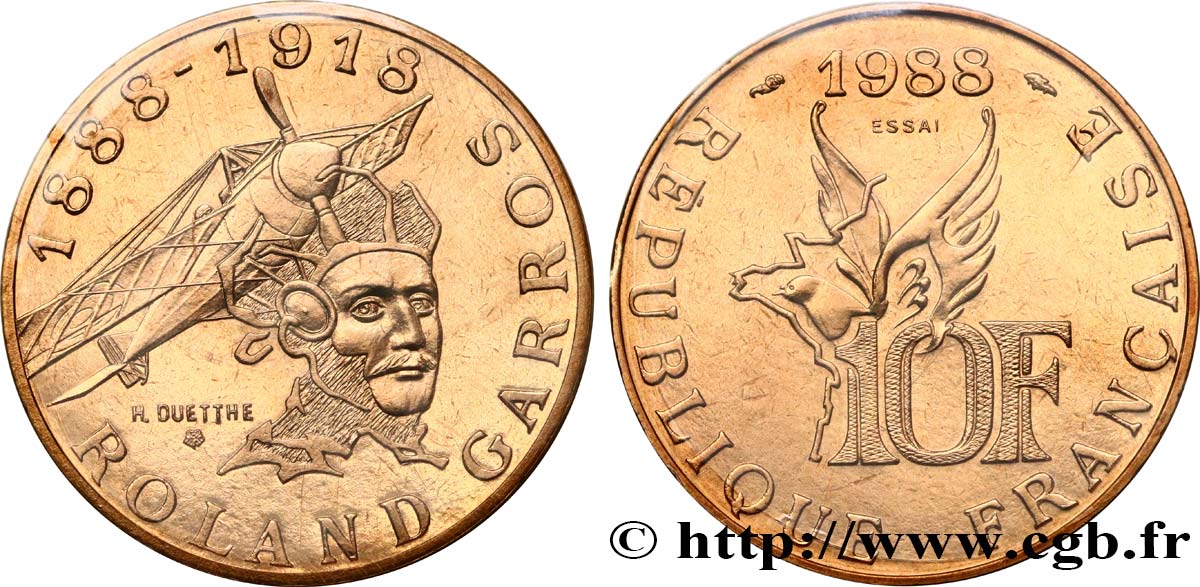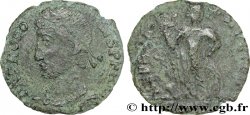E-auction 219-144288 - fmd_436552 - Essai de 10 francs Roland Garros, tranche B 1988 F.372/1
Чтобы принять участие в торгах, вы должны войти в систему и стать подтвержденным участником аукциона. Войдите, чтобы сделать ставку. Ваш аккаунт будет подтвержден в течение 48 часов. Не ждите до закрытия торгов, чтобы зарегистрироваться.Сделав ставку на данный товар, вы вступаете в юридическое соглашение на покупку выбранного товара и нажатием кнопки «Сделать ставку» подтверждаете принятие вами условий интернет-аукционов cgb.fr.
Ставка может бить сделана только в полном эквиваленте евро. Торги закроются согласно времени, указанному в описании товара, все ставки, сделанные после закрытия торгов, учитываться не будут. Не следует откладывать предложение вашей ставки до последнего момента, так как система может не успеть обработать вашу заявку, и ваша ставка не будет принята. Более детальную информацию вы найдёте здесь: FAQ по интернет-аукционам.
БЕСПЛАТНО.
БЕСПЛАТНО.
| Оценить : | 100 € |
| Цена : | 59 € |
| Максимальная предлагаемая цена : | 59 € |
| Конец торгов : | 26 June 2017 15:48:00 |
| Участников : | 8 Участников |
Тип Essai de 10 francs Roland Garros, tranche B
Дата: 1988
Количество отчеканенных монет: inclus
Металл: copper nickel
Диаметр: 26 mm
Ориентация осей монеты: 6 h.
Вес: 10 g.
Век: en creux. (branche de laurier) LIBERTE (branche d’olivier) EGALITE (épi) FRATERNITE
Комментарии о состоянии
Exemplaire sous sachet plastique scellé
Ссылки в каталоге: :
Лицевая сторона
Аверс: легенда: 1888 - 1918 / ROLAND GARROS.
Аверс: описание: Buste de Roland Garros à coté de son avion, une Demoiselle 20 ; signé H. DUETTHE et rosette de l'Atelier de Gravure sous l'avion.
Обратная сторона
Реверс: легенда: (DIFFÉRENT) 1988 (DIFFÉRENT) / RÉPUBLIQUE FRANÇAISE // 10 F.
Реверс: Описание: Littoral atlantique de la France se déployant en cigogne très stylisée.
Комментарий
L’analyse des trois exemplaires de cet essai en notre possession montre plusieurs détails qui indiquent des traitements plus que curieux à la fabrication. Les trois exemplaires ont une qualité de surface très bizarre avec des coups atténués dans les champs, adoucis, et on a franchement l’impression que les flans, avant la frappe, furent violemment choqués à de nombreuses reprises, puis repolis, puis frappés. En effet, non seulement aucune des traces de coups ne se trouve sur les zones en relief mais seulement dans les champs (ils étaient donc là avant la frappe et ont été écrasés par les reliefs de celle-ci ) mais les traces visibles sont mates et atténuées, comme si la surface avait été repolie.
Comment est-ce possible ? Nous l’ignorons. Tout se passe comme si les flancs avaient été stockés en sacs, secoués violemment et à de nombreuses reprises, puis repolis maladroitement.
Par ailleurs, sur certains exemplaires, les coins utilisés étaient rayés par un polissage mal réussi. Ces rayures se distinguent facilement tant des hairlines comme des rayures de la pièces car ils passent sous les détails de gravure sans interruption : ceci est parfaitement logique puisque le polissage du soin se fait sur le plat du coin, dont les détails sont en creux, sans que rien ne viennent arrêter ou interrompre l’abrasion.
L’un des trois exemplaires ne porte pas ces rayures de coin et semble avoir été repoli, probablement dans le but de les supprimer du coin. Cet exemplaire porte les rayures de coin.
Analysis of the three examples of this essay in our possession shows several details which indicate more than curious treatments during manufacturing.. All three examples have a very strange surface quality with attenuated blows in the fields, softened, and one frankly has the impression that the flans, before striking, were violently shocked many times, then repolished, then struck. In fact, not only are there no traces of blows on the raised areas but only in the fields (they were therefore there before the strike and were crushed by the reliefs of the latter) but the visible traces are matt and attenuated, as if the surface had been repolished.
How is this possible? We don't know.. It is as if the sides had been stored in bags, shaken violently and repeatedly, and then clumsily re-polished..
Furthermore, on some examples, the corners used were scratched by poor polishing.. These scratches are easily distinguished from both the hairlines and the scratches on the coins because they pass under the engraving details without interruption: this is perfectly logical since the polishing of the care is done on the flat of the corner, the details of which are in hollow, without anything stopping or interrupting the abrasion..
One of the three examples does not have these corner scratches and appears to have been repolished, probably in an attempt to remove them from the corner. This example has the corner scratches
Comment est-ce possible ? Nous l’ignorons. Tout se passe comme si les flancs avaient été stockés en sacs, secoués violemment et à de nombreuses reprises, puis repolis maladroitement.
Par ailleurs, sur certains exemplaires, les coins utilisés étaient rayés par un polissage mal réussi. Ces rayures se distinguent facilement tant des hairlines comme des rayures de la pièces car ils passent sous les détails de gravure sans interruption : ceci est parfaitement logique puisque le polissage du soin se fait sur le plat du coin, dont les détails sont en creux, sans que rien ne viennent arrêter ou interrompre l’abrasion.
L’un des trois exemplaires ne porte pas ces rayures de coin et semble avoir été repoli, probablement dans le but de les supprimer du coin. Cet exemplaire porte les rayures de coin.
Analysis of the three examples of this essay in our possession shows several details which indicate more than curious treatments during manufacturing.. All three examples have a very strange surface quality with attenuated blows in the fields, softened, and one frankly has the impression that the flans, before striking, were violently shocked many times, then repolished, then struck. In fact, not only are there no traces of blows on the raised areas but only in the fields (they were therefore there before the strike and were crushed by the reliefs of the latter) but the visible traces are matt and attenuated, as if the surface had been repolished.
How is this possible? We don't know.. It is as if the sides had been stored in bags, shaken violently and repeatedly, and then clumsily re-polished..
Furthermore, on some examples, the corners used were scratched by poor polishing.. These scratches are easily distinguished from both the hairlines and the scratches on the coins because they pass under the engraving details without interruption: this is perfectly logical since the polishing of the care is done on the flat of the corner, the details of which are in hollow, without anything stopping or interrupting the abrasion..
One of the three examples does not have these corner scratches and appears to have been repolished, probably in an attempt to remove them from the corner. This example has the corner scratches








 Cообщить об ошибке
Cообщить об ошибке Распечатать страницу
Распечатать страницу Отправить мой выбор
Отправить мой выбор Задать вопрос
Задать вопрос Consign / sell
Consign / sell
 Информация
Информация











